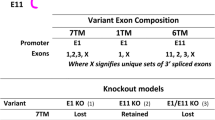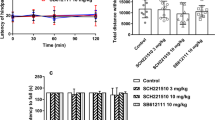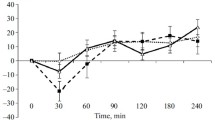Abstract
Although analgesia induced by blockade of opioid receptors has been well established, it is still unknown whether its development is mediated by the blockade of centrally located opioid receptors. Therefore, rats were treated with either systemically or ICV applied naloxone or quaternary naltrexone (QN), an opioid antagonist that does not easily penetrate the blood-brain barrier. Following antagonist administration, each animal was tested for paw lick latency on a 51° C hot plate. Hot plate testing and drug injections were carried out for 4 consecutive days. Rats treated with ICV microinjections of QN or naloxone displayed paw lick latencies that were significantly longer than those observed in control animals. In contrast, rats treated with SC injections of QN did not show any increase in paw lick latency, whereas rats treated with SC injections of naloxone displayed paw lick latencies that were significantly longer than those of control rats. These results are consistent with the hypothesis that the blockade of central opioid receptors underlies the development of an analgesic response.
Similar content being viewed by others
References
Cappell H, Poulos CX, Lê AD (1989a) Enhancement of naloxone-induced analgesia by pretreatment with morphine. Pharmacol Biochem Behav 34:425–427
Cappell H, Knoke DM, Lê AD, Poulos CX (1989b) Naloxone-induced analgesia: Effects of the benzodiazepine antagonist Ro 15-1788. Pharmacol Biochem Behav 34:197–200
Greeley JD (1987) Conditioned inhibition in a homeostatic response system: evidence from pharmacological conditioning with naloxone and morphine. A thesis submitted in conformity with the requirements of the degree of Doctor of Philosophy, Department of Psychology, University of Toronto, Toronto
Greeley JD, Westbrook RF (1990) Some effects of exposure to a heat stressor upon the rat's subsequent reactions to that stressor. J Exp Psychol B 42:1–40
Poulos CX, Knoke DM, Lê AD, Cappell H (1990) Naloxone-induced analgesia and morphine supersensitivity effects are contingent upon prior exposure to analgesic testing. Psychopharmacology 100:87–103
Rochford J, Stewart J (1987) Activation and expression of endogenous pain control mechanisms in rats given naloxone. Behav Neurosci 101:87–103
Stein C, Millan MJ, Shippenberg TS, Peter K, Herz A (1989) Peripheral opioid receptors mediating antinociception in inflammation. Evidence for involvement of mu, delta and kappa receptors. J Pharmacol Exp Ther 248:1269–1275
Suzuki T, Fukagawa Y, Misawa M, Nagase H (1990) “Paradoxical” analgesia and aggravated morphine dependence induced by opioid antagonists. Life Sci 47:515–521
van der Kooy D (1986) Hyperalgesic functions of peripheral opiate receptors. Ann NY Acad Sci 467:154–168
van der Kooy D, Nagy JI (1985) Hyperalgesia mediated by peripheral opiate receptors in the rat. Behav Brain Res 17:203–211
Walker MJK, Lê AD, Poulos CX, Cappell H (1991) Chronic selective blockade of opioid receptors produces analgesia and augmentation of the effects of a kappa agonist. Brain Res 538:181–186
Author information
Authors and Affiliations
Rights and permissions
About this article
Cite this article
Katharine Walker, M.J., Lê, A.D., Poulos, C.X. et al. Role of central versus peripheral opioid receptors in analgesia induced by repeated administration of opioid antagonists. Psychopharmacology 104, 164–166 (1991). https://doi.org/10.1007/BF02244172
Received:
Revised:
Issue Date:
DOI: https://doi.org/10.1007/BF02244172




